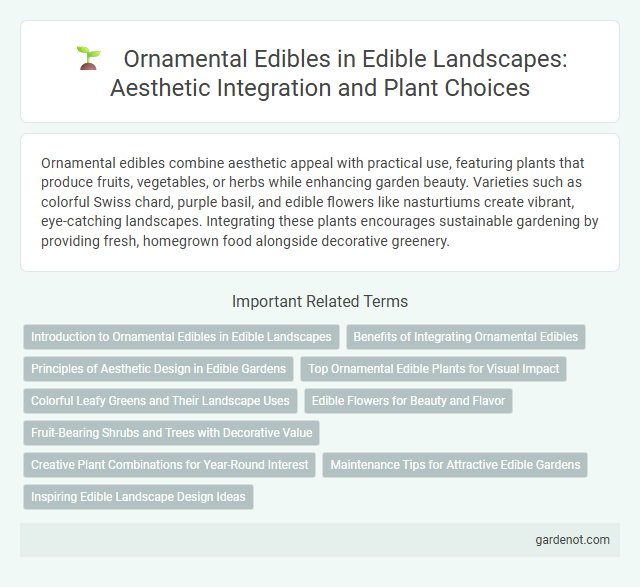Ornamental edibles combine aesthetic appeal with practical use, featuring plants that produce fruits, vegetables, or herbs while enhancing garden beauty. Varieties such as colorful Swiss chard, purple basil, and edible flowers like nasturtiums create vibrant, eye-catching landscapes. Integrating these plants encourages sustainable gardening by providing fresh, homegrown food alongside decorative greenery.
Introduction to Ornamental Edibles in Edible Landscapes
Ornamental edibles combine aesthetic appeal with practical use, transforming traditional landscapes into visually stunning and edible gardens. These plants include colorful vegetables, fruits, and herbs that enhance garden design while providing fresh, nutritious produce. Incorporating ornamental edibles in edible landscapes promotes sustainability, biodiversity, and year-round garden productivity.
Benefits of Integrating Ornamental Edibles
Integrating ornamental edible plants into landscapes enhances biodiversity by attracting pollinators and beneficial insects while providing aesthetically pleasing foliage and vibrant colors. These plants offer dual functionality, combining beauty with nutritional value, reducing the need for separate vegetable gardens and promoting sustainable urban agriculture. Incorporating varieties like purple basil, edible flowers, and colorful Swiss chard supports eco-friendly gardening and encourages local food production within residential or commercial green spaces.
Principles of Aesthetic Design in Edible Gardens
Ornamental edible plants integrate beauty and utility by emphasizing color contrast, texture variation, and balanced composition to create visually stunning edible gardens. Strategic placement of edible flowers, foliage, and fruits enhances seasonal interest while promoting biodiversity and sustainable harvesting practices. Combining form and function in garden design encourages both aesthetic appreciation and practical food production.
Top Ornamental Edible Plants for Visual Impact
Top ornamental edible plants like kale, nasturtiums, and rainbow chard combine vibrant colors with unique textures, enhancing both garden aesthetics and culinary value. These plants offer striking foliage and blooms that attract pollinators while providing nutritious leaves and flowers for salads and garnishes. Integrating such species into an edible landscape maximizes visual impact and edible yield, creating a multifunctional garden space.
Colorful Leafy Greens and Their Landscape Uses
Colorful leafy greens such as Swiss chard, red mustard, and rainbow kale provide vibrant hues that enhance edible landscapes while offering nutritional benefits. These ornamental edibles serve dual purposes by creating striking garden borders, containers, and ground covers that attract pollinators and support biodiversity. Their varied textures and colors also complement flowering plants, making them versatile choices for sustainable garden design.
Edible Flowers for Beauty and Flavor
Edible flowers such as nasturtiums, calendulas, and pansies provide vibrant colors and unique flavors to gardens, enhancing both aesthetics and culinary appeal. These ornamental edibles not only beautify landscapes but also offer nutrient-rich petals that elevate salads, desserts, and beverages. Incorporating edible flowers into outdoor spaces creates a multifunctional garden combining visual charm with delicious, healthful ingredients.
Fruit-Bearing Shrubs and Trees with Decorative Value
Fruit-bearing shrubs and trees such as blueberries, currants, and pomegranates combine ornamental beauty with edible yields, enhancing garden aesthetics while providing fresh produce. These species offer vibrant foliage, colorful fruits, and seasonal interest, making them ideal for edible landscaping designs focused on both function and visual appeal. Incorporating such plants supports biodiversity, attracts pollinators, and contributes to sustainable urban gardening practices.
Creative Plant Combinations for Year-Round Interest
Creative plant combinations in edible landscapes blend ornamental and edible species like colorful chard, purple basil, and bright nasturtiums to provide vibrant, year-round interest. Integrating perennial herbs such as rosemary and thyme with seasonal vegetables like kale and Swiss chard enhances texture and color diversity throughout all seasons. This approach maximizes garden productivity while maintaining aesthetic appeal, encouraging sustainable and visually captivating edible environments.
Maintenance Tips for Attractive Edible Gardens
Prune ornamental edible plants regularly to maintain their shape and encourage healthy growth, focusing on removing dead or diseased branches to boost vitality. Mulch around the base to retain moisture, suppress weeds, and regulate soil temperature, enhancing plant health and productivity. Monitor for pests and diseases frequently, using organic treatments when necessary, to preserve the aesthetic appeal and edibility of the garden.
Inspiring Edible Landscape Design Ideas
Inspiring edible landscape design ideas incorporate ornamental edibles such as colorful chard, vibrant kale, and flowering herbs like rosemary and thyme, blending aesthetics with functionality. These plants not only enhance visual appeal but also provide fresh culinary ingredients, creating a harmonious balance between beauty and utility. Strategically layering ornamental edibles in garden beds and containers maximizes space while promoting biodiversity and seasonal interest.
Ornamental edible Infographic

 gardenot.com
gardenot.com